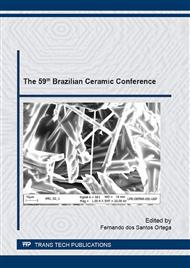p.3
p.7
p.12
p.18
p.24
p.30
p.35
p.41
p.46
Microwave Irradiation Applied to Calcination and Sintering of Strontium Titanate Ceramics
Abstract:
Alternative synthesis routes to obtain ceramics with advanced electronics applications have been investigated to improve the properties of these materials. Calcination and sintering by microwave irradiation is a very promising production method, which performs a rapid solid-state reaction and consolidation of particles due to the high heating rates (about 1000°C/min) aided by the microwave irradiation effect. To produce strontium titanate powder (SrTiO3 - STO), TiO2 and SrCO3 raw precursors were mixture in a ball mill for 3.5 h and after, this mixture was dried at 70°C for 24h. The resulting mixture was divided in two portions to produce STO powders following two procedures: (i) in the conventional method (STO-cC), the mixture was calcined at 1000°C with a heating rate of 10oC/min for 2h, and (ii) in the microwave method (uC) other part of mixture was calcined at 1000°C with a heating rate of 1000°C/min for 15 min, 30 min and 60 min. The powders obtained by both methods were characterized by X-ray diffraction (XRD) to evaluate the crystalline phase presents in the powders. The STO crystalline phase was identified in both samples, but it was also noted the presence of SrCO3 spurious phase in the STO-cC and STO-uC (15 and 30min). On the other hand, STO-uC powder calcined for 60 minutes did not showed this spurious phase. Dilatometric analysis was performed on STO-cC and STO-uC (60min) discs shaped powders by uniaxial load pressing (180 MPa) in order to determine the sintering temperature. Green bodies were sintered at 1380oC in conventional oven for 2h (cS) and in microwave oven at three different soaking times: 15, 30 and 60 minutes (uS). The microstructures of the cS and uS ceramics were analyzed by scanning electron microscopy (SEM). Significant difference between densification of the STO-cC-cS (88%) and STO-uC-uS (99%) ceramics were obtained to ceramics sintered by 60 minutes. The values of grain size of ceramics obtained by uC/uS indicates that microwave irradiation is an effective technique to avoid grain growth.
Info:
Periodical:
Pages:
24-29
Citation:
Online since:
November 2016
Keywords:
Price:
Сopyright:
© 2017 Trans Tech Publications Ltd. All Rights Reserved
Share:
Citation:


